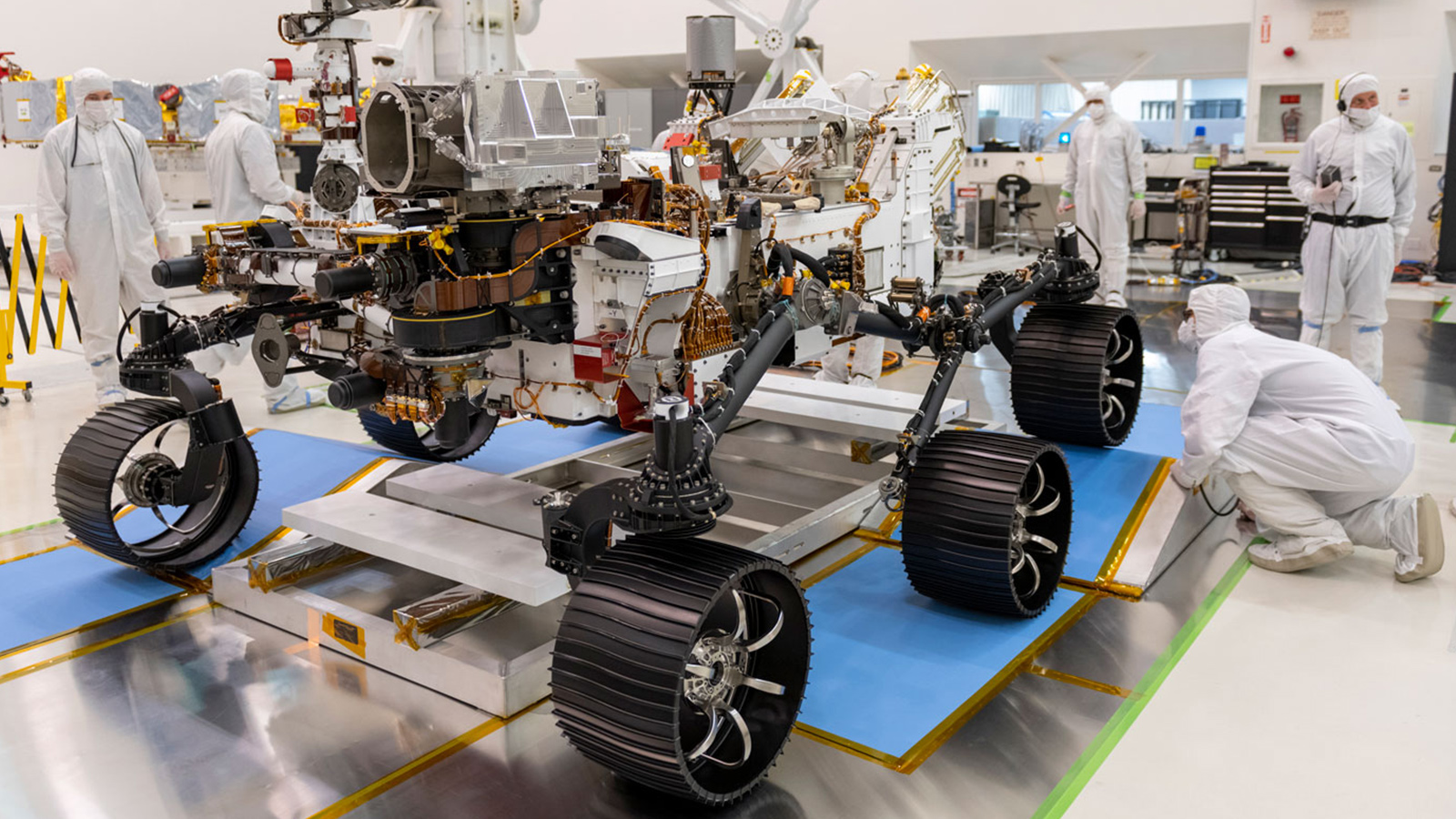UPDATED: NASA’s next Mars rover is on its way
By Cat Hofacker|July 30, 2020
Perseverance rover will add human-oriented science to the hunt for microbial life
NASA’s next Mars rover, which began its journey to the red planet today, is about the size of a sport utility vehicle, an analog that’s fitting because NASA wants it to have even more utility than the current rover, Curiosity.
The Perseverance rover, its heat shield and retrorocket-and-tether-based sky crane landing apparatus were launched atop an Atlas V rocket from Cape Canaveral Air Force Station in Florida at 7:50 a.m. local time. The spacecraft now has a seven-month trip to Mars that will culminate in a landing on Feb. 18, 2021.
If Perseverance sticks its landing, as Curiosity did, the six-wheeled vehicle will roll across the 45-kilometer-wide Jezero Crater, containing an ancient river delta where evidence of past microbial life may be preserved in rocks and clay, scientists believe. This primary aspect of the mission is distinct from Curiosity’s investigation in that Curiosity is focused on determining whether the chemical ingredients for life existed or may still exist on Mars, rather than searching for evidence of microbes. Perseverance’s multicamera Mastcam-Z instrument, similar to Curiosity’s, will take color pictures and video of rocks and soil from its white rectangular housing atop the rover’s mast. This time, though, the rover also will cache samples for a future European rover to collect and stow in a capsule aboard a small ascent rocket, which will deliver them to another spacecraft in Mars orbit that will carry them to Earth for a descent to the Utah desert in 2031.
Along with providing a more complete picture of what awaits future human explorers of Mars, analyzing these samples is good practice for astronauts who might one day collect additional samples either on their own or by dispatching rovers, said Arya Udry, a professor of planetary science at the University of Las Vegas who specializes in Martian geology.
Two cameras mounted to the turret at the end of the rover’s robotic arm will take additional pictures, while another on the mast will shoot a laser at nearby rocks, vaporizing them into plasma for an onboard spectrometer to analyze their composition. If the spectrometer detects biosignatures, Perseverance’s drill will grind up some of the rock and soil. A smaller robotic arm will hold up sample tubes to be filled, then stow them in the belly of the rover.
In the same way, astronauts “need to know what they’re bringing back and need to know how to be able to analyze a sample,” Udry told me.
The addition of these sampling tubes and different sized drill bits for extracting both powdery soil and chunks of rock from Mars makes Perseverance about 125 kilograms heavier than Curiosity, whose frame is nearly identical.
Perseverance also has a different mix of instruments from Curiosity’s, including the addition of experiments specifically tailored for future human missions possibly beginning in the mid-2030s.
“I’ve been involved with the Mars missions for a long time, and this one is entirely unique in thinking about today, tomorrow and the day after tomorrow,” said Michael Hecht, a researcher at the Massachusetts Institute of Technology and the principal investigator for one such instrument, MOXIE.
Short for Mars Oxygen In-Situ Resource Utilization Experiment, MOXIE will attempt to show how oxygen could be culled from the Martian atmosphere as a step toward making breathable air for future human explorers.
Funded by NASA’s Human Exploration and Operations Mission Directorate, this collection of compressors, inlets and an electrolyzer will attempt to extract oxygen from carbon dioxide with electricity through electrolysis. The roughly 17-kilogram machine, about the size of a car battery, will suck in carbon dioxide via an inlet for compression, then push the gas through an electrolyzer that heats it to separate the carbon and oxygen atoms.
NASA wants to run the machine 10 times throughout Perseverance’s two-year mission in hour-long periods, during which Hecht estimates MOXIE can produce between 6 and 10 grams of oxygen. In one scenario of a future human mission to Mars, Hecht said, a version of MOXIE about the size of a refrigerator, capable of producing 2 to 3 kilograms of oxygen an hour, could be launched to Mars along with an external oxygen tank years before a crew, giving astronauts a ready supply for breathing and conversion into rocket fuel upon their arrival.
“If we can reduce the load that we not only have to carry to Mars but all [the equipment] that’s needed to land and set up in one place,” that speeds up the timeline for a human mission, Hecht said.
Along with culling oxygen, the Perseverance mission could provide astronauts with a way to scout places on Mars that landers and rovers can’t traverse. Stashed under the belly of the rover is a 1.8-kilogram helicopter named Ingenuity, which in 2021 will attempt up to five powered flights. Ingenuity’s four carbon fiber blades must spin at a rate of about 2,400 revolutions per minute, or 10 times faster than helicopters on Earth, because the Martian atmosphere is 100 times thinner than Earth’s.
Future aerial vehicles could also serve as communications relays between astronauts when they travel out of range of their rover, said Michelle Rucker, a Mars Integration Group lead at Johnson Space Center in Texas, during a prelaunch briefing.
“That helicopter, we have all kind of ideas for how to use that for a human Mars mission,” she said.
Related Topics
Space Science





